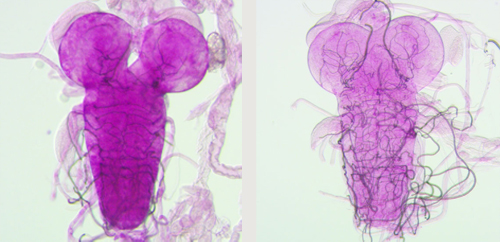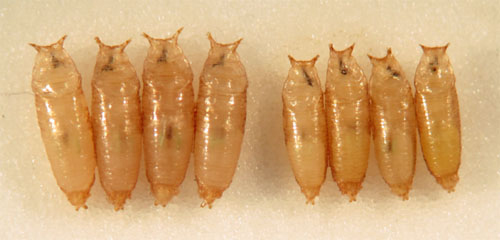
News and Announcements from the CDB
Sugars such as glucose circulating in the blood and stored in tissues are important sources of energy and carbon necessary for living organisms to maintain metabolic homeostasis. In many invertebrates, including insects, trehalose is the predominant sugar found circulating in the blood (or hemolymph). The unique chemical properties of trehalose are thought to protect organisms from environmental stresses such as desiccation and changes in temperature. Trehalose levels in the hemolymph are known to be regulated by a pair of endocrine hormones, similar to how insulin and glucagon regulate glucose levels in humans, to control the glycometabolism of an organism in response to availability of nutrients. However, the precise function of trehalose during the process of development remains largely unknown.
In a new study carried out by research scientist Hiroko Matsuda and technical staff Takayuki Yamada in the Laboratory for Growth Control Signaling (Takashi Nishimura, Team Leader) and others, published in the Journal of Biological Chemistry, they use the Drosophila system to analyze the physiological role of trehalose. Their findings reveal that trehalose plays an important role in regulating glycometabolism and growth as well as on the viability of the fly, especially when there are changes in external factors such as nutrient availability.

Central nervous system of larval stage Drosophila. After starvation, glycogen levels of the Tps1 mutant (right)
are markedly reduced compared with wildtype (left).
In Drosophila, glycogen, the main storage form of glucose, is stored in tissues, whereas trehalose is found stored and circulating in relatively high concentrations in the hemolymph. When needed, these storage sugars are broken down into glucose, which is used by tissues to produce energy in the form of ATP. In this study, to understand the role of trehalose during development, Matsuda et al. generated Drosophila mutants that lacked the trehalose-synthesizing enzyme, trehalose-6-phosphate synthase (Tps1), and compared their developmental physiology with wildtype flies.
The group first examined the levels of trehalose in wildtype flies at different developmental stages. Trehalose was undetected in early stage embryos, but as development progressed from late embryonic to larval stages, trehalose levels began to rise significantly, and during the pupal period, saw a sharp decline. These observations suggested that trehalose was synthesized during embryonic and larval development, and then consumed during pupal development. They also confirmed that the main site of trehalose synthesis was the fat body, an organ with functions similar to the mammalian liver. When development of Tps1 mutants was examined, as expected, trehalose production and trehalose was not detected. When grown under normal nutrient conditions, the mutants displayed relatively normal development until the pupal stage, albeit slightly smaller in size than wildtype; but, they died before eclosion. Thus, while trehalose is important for viability of the fly, their findings suggest that it is not essential for larval development up to the pupal stage, at least under normal nutrient conditions.
So Matsuda et al. next investigated how dietary stress (starvation) would affect the larval period of Tps1 mutants. When the mutant larvae were placed on a water-only diet, most died after the first day of starvation, while wildtype larvae survived at least three days on the same diet. The starved Tps1 mutant larvae showed no major changes in the levels of ATP and of hormones that regulate energy metabolism, and also began producing energy by breaking down the proteins and stored fat in the body, as is seen in starved wildtype larvae. However, a closer examination revealed a significant reduction in glycogen levels in the central nervous system of the Tps1 mutants. Many cells in the brain also underwent apoptosis. Thus, the lack of trehalose synthesis in Tps1 mutants results in a localized depletion of energy sources in brain cells which use glucose as its primary source of energy, causing defects in the brain and likely lethality.

Under low protein conditions, the pupa sizes Tps1 mutants (right) are smaller than wildtype (left).
The group further tested the effects of nutrient availability on the development of Tps1 mutants, placing them under a number of different dietary conditions. Under a low-sugar diet, the mutant larvae died before the pupal stage. In contrast, under a low-protein (normal sugar) diet, most of the mutant larvae reached the pupal stage, but with a delay in the timing of puparium formation and a markedly smaller pupa sizes. An analysis of the developmental physiology revealed that Tps1 mutants had reduced insulin/insulin-like growth factor signaling activity, which is involved in growth control of the fly.
“Our study showed that Tps1 mutants can survive to the pupal stage if dietary sugar is available, but die before eclosion, so we would like to close in on the exact role trehalose plays during the pupal period,” says Nishimura. “It would also be interesting to understand how the Drosophila uses the two storage sugars, glycogen and trehalose, for the same or different purposes.”
| Link to article |
|---|